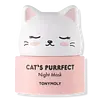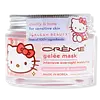What's inside
What's inside
 Key Ingredients
Key Ingredients

 Benefits
Benefits

 Concerns
Concerns

 Ingredients Side-by-side
Ingredients Side-by-side

Water
Skin ConditioningButylene Glycol
HumectantGlycerin
HumectantDimethicone
EmollientNiacinamide
SmoothingHydrogenated Poly(C6-14 Olefin)
EmollientErythritol
HumectantCetyl Ethylhexanoate
EmollientPrunus Armeniaca Kernel Oil
MaskingSorbitan Stearate
EmulsifyingDimethicone/Vinyl Dimethicone Crosspolymer
Skin ConditioningPolysorbate 60
EmulsifyingGlyceryl Stearate
EmollientPEG-100 Stearate
Hydroxyacetophenone
AntioxidantAcrylates/C10-30 Alkyl Acrylate Crosspolymer
Emulsion StabilisingSodium Polyacrylate Starch
AbsorbentCetearyl Stearate
Skin ConditioningEthylhexylglycerin
Skin ConditioningOlea Europaea Fruit Oil
MaskingPolyglyceryl-10 Myristate
Skin ConditioningAllantoin
Skin ConditioningAdenosine
Skin ConditioningDisodium EDTA
Cymbopogon Martini Oil
MaskingCitrus Aurantium Bergamia Fruit Oil
MaskingCentella Asiatica Extract
CleansingPelargonium Graveolens Flower Oil
MaskingPortulaca Oleracea Extract
Skin ConditioningEucalyptus Globulus Leaf Oil
PerfumingChamomilla Recutita Flower Extract
MaskingVitex Agnus-Castus Extract
AstringentCitrus Aurantium Dulcis Peel Oil
MaskingArctium Lappa Root Extract
Skin ConditioningPhellinus Linteus Extract
Skin ConditioningMichelia Alba Flower Oil
MaskingArginine
MaskingCarbomer
Emulsion StabilisingLonicera Japonica Flower Extract
Skin ConditioningPropolis Extract
Skin ConditioningRoyal Jelly Extract
Skin ConditioningScutellaria Baicalensis Root Extract
AstringentSilk Amino Acids
HumectantSodium Hyaluronate
HumectantGlyceryl Glucoside
HumectantCaprylic/Capric Triglyceride
MaskingHydrogenated Lecithin
EmulsifyingCeramide NP
Skin ConditioningWater, Butylene Glycol, Glycerin, Dimethicone, Niacinamide, Hydrogenated Poly(C6-14 Olefin), Erythritol, Cetyl Ethylhexanoate, Prunus Armeniaca Kernel Oil, Sorbitan Stearate, Dimethicone/Vinyl Dimethicone Crosspolymer, Polysorbate 60, Glyceryl Stearate, PEG-100 Stearate, Hydroxyacetophenone, Acrylates/C10-30 Alkyl Acrylate Crosspolymer, Sodium Polyacrylate Starch, Cetearyl Stearate, Ethylhexylglycerin, Olea Europaea Fruit Oil, Polyglyceryl-10 Myristate, Allantoin, Adenosine, Disodium EDTA, Cymbopogon Martini Oil, Citrus Aurantium Bergamia Fruit Oil, Centella Asiatica Extract, Pelargonium Graveolens Flower Oil, Portulaca Oleracea Extract, Eucalyptus Globulus Leaf Oil, Chamomilla Recutita Flower Extract, Vitex Agnus-Castus Extract, Citrus Aurantium Dulcis Peel Oil, Arctium Lappa Root Extract, Phellinus Linteus Extract, Michelia Alba Flower Oil, Arginine, Carbomer, Lonicera Japonica Flower Extract, Propolis Extract, Royal Jelly Extract, Scutellaria Baicalensis Root Extract, Silk Amino Acids, Sodium Hyaluronate, Glyceryl Glucoside, Caprylic/Capric Triglyceride, Hydrogenated Lecithin, Ceramide NP
Water
Skin ConditioningButylene Glycol
HumectantPEG-240
HumectantCaprylic/Capric Triglyceride
MaskingDipropylene Glycol
HumectantHydroxyacetophenone
AntioxidantPEG-100 Stearate
Dimethicone
EmollientGlyceryl Stearate
EmollientGlycerin
HumectantGlycereth-26
HumectantMacadamia Ternifolia Seed Oil
EmollientCaprylyl Glycol
EmollientAllantoin
Skin ConditioningNiacinamide
SmoothingTocopheryl Acetate
AntioxidantAdenosine
Skin ConditioningDisodium EDTA
1,2-Hexanediol
Skin ConditioningDipotassium Glycyrrhizate
HumectantFragaria Chiloensis Fruit Extract
Skin ConditioningHydrolyzed Hyaluronic Acid
HumectantSodium Acetylated Hyaluronate
HumectantAstragalus Membranaceus Root Extract
EmollientCnidium Officinale Root Extract
Skin ConditioningAngelica Gigas Root Extract
Skin ConditioningRehmannia Glutinosa Root Extract
Skin ConditioningPanax Ginseng Root Extract
EmollientGlycyrrhiza Glabra Root Extract
BleachingAtractylodes Japonica Rhizome Extract
Skin ConditioningPoria Cocos Extract
Skin ConditioningPrunus Mume Flower Extract
Skin ConditioningOenothera Biennis Seed Extract
Skin ConditioningPaeonia Lactiflora Root Extract
Skin ConditioningCinnamomum Cassia Bark
Skin ConditioningCinnamomum Cassia Bark Extract
MaskingCetyl Ethylhexanoate
EmollientEclipta Prostrata Extract
Skin ConditioningLithospermum Erythrorhizon Root Oil
Skin ConditioningBrassica Campestris Seed Oil
Skin ConditioningSchisandra Chinensis Fruit Extract
Skin ConditioningMelia Azadirachta Leaf Extract
Skin ConditioningMoringa Oleifera Seed Oil
EmollientMelia Azadirachta Flower Extract
Skin ConditioningCoccinia Indica Fruit Extract
Skin ConditioningSolanum Melongena Fruit Extract
Skin ConditioningSimmondsia Chinensis Seed Oil
EmollientOcimum Sanctum Leaf Extract
Skin ConditioningCorallina Officinalis Extract
Skin ConditioningCurcuma Longa Root Extract
MaskingParfum
MaskingWater, Butylene Glycol, PEG-240, Caprylic/Capric Triglyceride, Dipropylene Glycol, Hydroxyacetophenone, PEG-100 Stearate, Dimethicone, Glyceryl Stearate, Glycerin, Glycereth-26, Macadamia Ternifolia Seed Oil, Caprylyl Glycol, Allantoin, Niacinamide, Tocopheryl Acetate, Adenosine, Disodium EDTA, 1,2-Hexanediol, Dipotassium Glycyrrhizate, Fragaria Chiloensis Fruit Extract, Hydrolyzed Hyaluronic Acid, Sodium Acetylated Hyaluronate, Astragalus Membranaceus Root Extract, Cnidium Officinale Root Extract, Angelica Gigas Root Extract, Rehmannia Glutinosa Root Extract, Panax Ginseng Root Extract, Glycyrrhiza Glabra Root Extract, Atractylodes Japonica Rhizome Extract, Poria Cocos Extract, Prunus Mume Flower Extract, Oenothera Biennis Seed Extract, Paeonia Lactiflora Root Extract, Cinnamomum Cassia Bark, Cinnamomum Cassia Bark Extract, Cetyl Ethylhexanoate, Eclipta Prostrata Extract, Lithospermum Erythrorhizon Root Oil, Brassica Campestris Seed Oil, Schisandra Chinensis Fruit Extract, Melia Azadirachta Leaf Extract, Moringa Oleifera Seed Oil, Melia Azadirachta Flower Extract, Coccinia Indica Fruit Extract, Solanum Melongena Fruit Extract, Simmondsia Chinensis Seed Oil, Ocimum Sanctum Leaf Extract, Corallina Officinalis Extract, Curcuma Longa Root Extract, Parfum
 Reviews
Reviews

Ingredients Explained
These ingredients are found in both products.
Ingredients higher up in an ingredient list are typically present in a larger amount.
Adenosine is in every living organism. It is one of four components in nucleic acids that helps store our DNA.
Adenosine has many benefits when used. These benefits include hydrating the skin, smoothing skin, and reducing wrinkles. Once applied, adenosine increases collagen production. It also helps with improving firmness and tissue repair.
Studies have found adenosine may also help with wound healing.
In skincare products, Adenosine is usually derived from yeast.
Learn more about AdenosineAllantoin is a soothing ingredient known for its protective and moisturizingg properties. Because of this, it is often added to products with strong active ingredients.
Studies show higher concentrations of this ingredient can promote wound healing.
Though it can be derived from the comfrey plant, allantoin is produced synthetically for cosmetic products to ensure purity.
Learn more about AllantoinButylene Glycol (or BG) is used within cosmetic products for a few different reasons:
Overall, Butylene Glycol is a safe and well-rounded ingredient that works well with other ingredients.
Though this ingredient works well with most skin types, some people with sensitive skin may experience a reaction such as allergic rashes, closed comedones, or itchiness.
Learn more about Butylene GlycolThis ingredient is an emollient, solvent, and texture enhancer. It is considered a skin-softener by helping the skin prevent moisture loss.
It helps thicken a product's formula and makes it easier to spread by dissolving clumping compounds.
Caprylic Triglyceride is made by combining glycerin with coconut oil, forming a clear liquid.
While there is an assumption Caprylic Triglyceride can clog pores due to it being derived from coconut oil, there is no research supporting this.
Learn more about Caprylic/Capric TriglycerideCetyl Ethylhexanoate is an emollient ester. It comes from cetearyl alcohol and 2-ethylhexanoic acid.
Cetyl Ethylhexanoate is an emollient that adds a velvety feel to skin without being greasy or oily. Emollients help trap moisture into your skin, keeping your skin soft and hydrated.
Dimethicone is a type of synthetic silicone created from natural materials such as quartz.
What it does:
Dimethicone comes in different viscosities:
Depending on the viscosity, dimethicone has different properties.
Ingredients lists don't always show which type is used, so we recommend reaching out to the brand if you have questions about the viscosity.
This ingredient is unlikely to cause irritation because it does not get absorbed into skin. However, people with silicone allergies should be careful about using this ingredient.
Note: Dimethicone may contribute to pilling. This is because it is not oil or water soluble, so pilling may occur when layered with products. When mixed with heavy oils in a formula, the outcome is also quite greasy.
Learn more about DimethiconeDisodium EDTA plays a role in making products more stable by aiding other preservatives.
It is a chelating agent, meaning it neutralizes metal ions that may be found in a product.
Disodium EDTA is a salt of edetic acid and is found to be safe in cosmetic ingredients.
Learn more about Disodium EDTAGlycerin is already naturally found in your skin. It helps moisturize and protect your skin.
A study from 2016 found glycerin to be more effective as a humectant than AHAs and hyaluronic acid.
As a humectant, it helps the skin stay hydrated by pulling moisture to your skin. The low molecular weight of glycerin allows it to pull moisture into the deeper layers of your skin.
Hydrated skin improves your skin barrier; Your skin barrier helps protect against irritants and bacteria.
Glycerin has also been found to have antimicrobial and antiviral properties. Due to these properties, glycerin is often used in wound and burn treatments.
In cosmetics, glycerin is usually derived from plants such as soybean or palm. However, it can also be sourced from animals, such as tallow or animal fat.
This ingredient is organic, colorless, odorless, and non-toxic.
Glycerin is the name for this ingredient in American English. British English uses Glycerol/Glycerine.
Learn more about GlycerinGlyceryl Stearate is a mix of glycerin and stearic acid.
It is used to stabilize the mixing of water and oil ingredients. By preventing these ingredients from separating, it can help elongate shelf life. It can also help thicken the product's texture.
As an emollient, it helps soften skin and supports barrier-replenishing ingredients.
In cosmetics, Glyceryl Stearate is often made from vegetable oils or synthetically produced.
This ingredient may not be fungal-acne safe
Fun fact: The human body also creates Glyceryl Stearate naturally.
Learn more about Glyceryl StearateHydroxyacetophenone is antioxidant with skin conditioning and soothing properties. It also boosts the efficiency of preservatives.
This ingredient is not irritating or sensitizing.
Niacinamide is a multitasking form of vitamin B3 that strengthens the skin barrier, reduces pores and dark spots, regulates oil, and improves signs of aging.
And the best part? It's gentle and well-tolerated by most skin types, including sensitive and reactive skin.
You might have heard of "niacin flush", or the reddening of skin that causes itchiness. Niacinamide has not been found to cause this.
In very rare cases, some individuals may not be able to tolerate niacinamide at all or experience an allergic reaction to it.
If you are experiencing flaking, irritation, and dryness with this ingredient, be sure to double check all your products as this ingredient can be found in all categories of skincare.
When incorporating niacinamide into your routine, look out for concentration amounts. Typically, 5% niacinamide provides benefits such as fading dark spots. However, if you have sensitive skin, it is better to begin with a smaller concentration.
When you apply niacinamide to your skin, your body converts it into nicotinamide adenine dinucleotide (NAD). NAD is an essential coenzyme that is already found in your cells as "fuel" and powers countless biological processes.
In your skin, NAD helps repair cell damage, produce new healthy cells, support collagen production, strengthen the skin barrier, and fight environmental stressors (like UV and pollution).
Our natural NAD levels start to decline with age, leading to slower skin repair, visible aging, and a weaker skin barrier. By providing your skin niacinamide, you're recharging your skin's NAD levels. This leads to stronger, healthier, and younger looking skin.
Another name for vitamin B3 is nicotinamide. This vitamin is water-soluble and our bodies don't store it. We obtain Vitamin B3 from either food or skincare. Meat, fish, wheat, yeast, and leafy greens contain vitamin B3.
The type of niacinamide used in skincare is synthetically created.
Learn more about NiacinamidePeg-100 Stearate is an emollient and emulsifier. As an emollient, it helps keep skin soft by trapping moisture in. On the other hand, emulsifiers help prevent oil and water from separating in a product.
PEGS are a hydrophilic polyether compound . There are 100 ethylene oxide monomers in Peg-100 Stearate. Peg-100 Stearate is polyethylene glycol ester of stearic acid.
Water. It's the most common cosmetic ingredient of all. You'll usually see it at the top of ingredient lists, meaning that it makes up the largest part of the product.
So why is it so popular? Water most often acts as a solvent - this means that it helps dissolve other ingredients into the formulation.
You'll also recognize water as that liquid we all need to stay alive. If you see this, drink a glass of water. Stay hydrated!
Learn more about Water